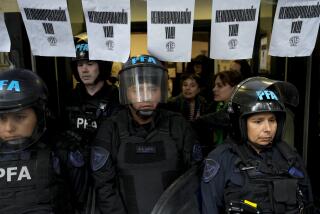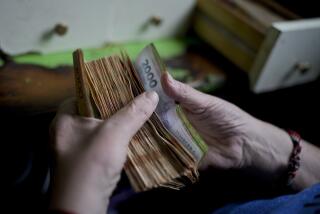Are good times in Argentina for real or an illusion?
- Share via
Reporting from Buenos Aires — In Argentina, soybean production is flying high. That means another banner year for farm equipment salesman Carlos Meniavere.
His company, Apache, expects sales of its planters and harvesters to increase 20% this year over 2010. Local demand for his machines, costing $75,000 and up, has risen sharply. So have foreign sales. Apache’s relatively low manufacturing costs have led to deals with buyers in Brazil, Venezuela, Russia and other markets.
“We’re going to sell 400 units this year and export to 10 countries. It’s a good year in every sense of the word,” said Meniavere, whose company is based in Las Parejas, about 250 miles west of the capital in Argentina’s farm belt.
Times are good in much of Argentina, where farm and manufacturing booms have set the economy on fire the last two years. Incomes are rising. Poverty is in decline. Argentines are buying cars and taking foreign vacations.
The United Nations forecasts the country’s economy will grow 8% this year, well above the 2.5% expansion some predict this year for the U.S. That’s on top of Argentina’s 9% growth in 2010. The biggest driver is exports, which are expected to reach $80 billion this year. That’s triple what they were in 2002, when the country was mired in a financial crisis.
But major challenges loom. Analysts and industry leaders warn the country’s fortunes could decline unless President Cristina Fernandez de Kirchner sharply reduces consumer subsidies and reins in galloping inflation that could reach 25% this year.
Rising concerns about a devaluation of the peso have caused a resurgence of the capital flight that hastened the country’s economic crisis in 2001. Economist Gustavo Canonero of Deutsche Bank in Buenos Aires said $10 billion left the country in the first half of 2011 as Argentines changed pesos for dollars. He is concerned that flight could accelerate over the remainder of the year.
At the same time, the competitive advantages that Argentine companies such as Apache have enjoyed over the last decade are evaporating because of rising labor costs.
“No one questions that the economy is running well, but it’s running on steroids,” said Alberto Ramos of Goldman Sachs, who added that the high cost of subsidies and welfare programs are beginning to tell. “It may be like the sprinter who runs fine for 60 yards and then tires.”
Salesman Meniavere showcased his company’s equipment last month at La Rural, an annual agricultural fair in the capital. Several of his company’s bright-red farm machines were displayed among the Angus bulls, prize hens and quarter horses. The atmosphere was upbeat, with a number of exhibitors saying times are good.
Indeed, Argentina — a country known for gauchos, red wine and the tango — is living a golden moment. Construction is on a roll. So is auto manufacturing. Auto plants are projected to turn out 900,000 cars and trucks this year, 26% more than 2010, on top of 29% unit growth last year.
“It’s a very encouraging prospect,” said Osvaldo Kacef, a United Nations economist in Santiago, Chile. He noted that Argentina’s projected economic growth for this year is far above the 4.7% expansion he expects for the Latin American and Caribbean region as a whole.
It’s all a remarkable turnaround from the 2001-02 economic crisis, when Argentina defaulted on $130 billion in bonds, sharply devalued its currency and suffered through an economic contraction that cost tens of thousands of jobs. Weeks of civil unrest turned the capital into a war zone.
Then along came the global spike in commodities prices, fed principally by growing demand from Asia. Argentina’s annual soy harvest has risen 67% over the last decade. This year, farmers will reap an anticipated 50 million tons. That’s creating a bonanza for producers as well as for the government, which taxes it heavily.
Soy exports last year rose to $17.1 billion, nearly quadruple the $4.6 billion in foreign shipments in 2001, according to government statistics. The commodity accounted for one-quarter of Argentina’s total exports of $68.5 billion last year.
But there was another important factor in Argentina’s recovery: the competitiveness of the country’s manufacturers.
The 2002 devaluation of the peso cut minimum wages by two-thirds, left half the nation’s manufacturing capacity idle and put legions of skilled workers on the streets desperate for work. When factories got rolling again, production costs of steel, appliances, plastic tubing and autos were considerably lower than those of most other countries in the region, said Dante Sica, director of Abeceb.com, an economic consulting firm in Buenos Aires.
“As a result, every Argentine manufacturing sector has shown solid gains since 2001,” Sica said, adding that more than 3 million jobs have been created over the last decade, twice as many as in the previous decade. “All the government had to do was create incentives for [consumer] demand.”
But Abel Viglione, senior economist at the FIEL economics think tank in Buenos Aires, said Kirchner’s government has overdone the incentives. Subsidies for a broad range of goods and services — including gasoline, electricity and bread — will total about $15 billion this year.
“Electricity rates have not changed since 2001, while the cost of producing it has risen 150%. Gasoline costs about 70% of the market rates in other countries. The government pays the difference,” Viglione said.
Price controls limit the amount that oil companies can charge for crude, natural gas and refined products. Many of those firms have reduced their Argentina investment in recent years, seeking better returns elsewhere. The upshot: oil and gas output and reserves have plummeted, said Daniel Gerold of G&G Energy Consultants in Buenos Aires.
Argentina now produces about 600,000 barrels of crude a day, down 28% from the 1998 peak — not because oil resources are running out, but because the energy business is unprofitable for most companies, Gerold said.
That’s forcing the government to import oil and gas that Argentina used to produce on its own. Gerold expects Argentina’s energy trade deficit to hit $3 billion this year, compared with a $6-billion surplus as recently as 2007.
“The good times are an illusion, like a vacation at Disney World. And Argentina’s stay at Disney is about to end,” said Gerold, who predicted that the government will have to soon reduce or eliminate fuel subsidies.
The subsidies, combined with expanded government welfare programs, have reduced Argentina’s poverty rate to 21% from nearly 40% a decade ago. The measures have solidified Kirchner’s political base as she revs up her campaign for reelection in October. At this point, most pundits pick her to win.
But a patchwork of special tariffs and taxes that attempt to force producers of foodstuffs, energy and household goods to keep domestic prices low are distorting the economy, several analysts said.
“I’m not debating the subsidies on their merits or social needs but on their efficiency as mechanisms,” said Ramos of Goldman Sachs. “When electricity or gas in an entire city is subsidized, you’re helping rich homeowners who can afford to pay the full price. Bus riders are subsidizing the guy who drives a Ferrari.”
More to Read
Inside the business of entertainment
The Wide Shot brings you news, analysis and insights on everything from streaming wars to production — and what it all means for the future.
You may occasionally receive promotional content from the Los Angeles Times.










